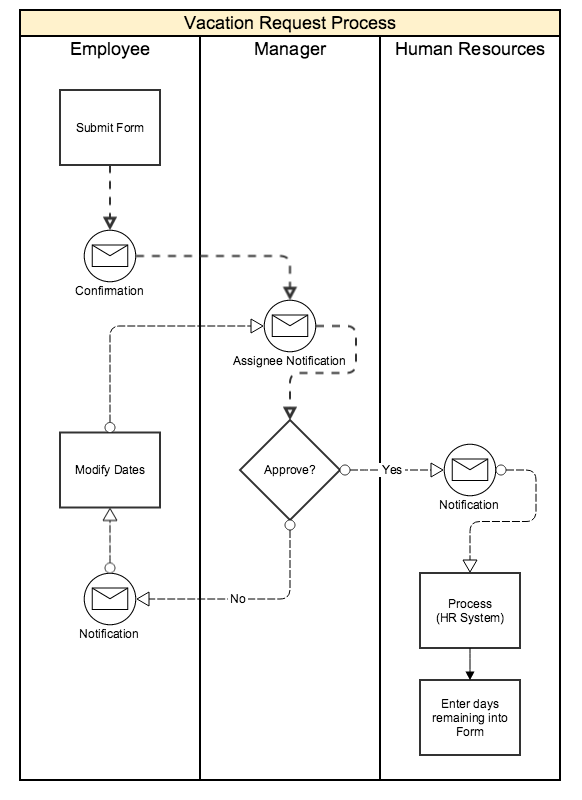
Organisations tend to grow organically, and just like their botanical counterparts, it can be very rewarding to watch them grow with the right conditions and care. At some point though, if you’re not careful, they can start to sprout and sprawl uncontrollably in all directions until one day you find that they’ve started to strangle themselves, and even others.
Organisations strangle themselves by failing to adapt to growth. Processes that worked perfectly at the beginning with just one person often become inefficient, even painful, as new team members join.
 The symptoms of painful processes are easy to spot; greater stress, excessive but poor communication, low levels of commitment and energy, bottlenecks, email overload, repetitive status meetings, out of date spreadsheets, dysfunctional politics, low productivity… the list goes on.
The symptoms of painful processes are easy to spot; greater stress, excessive but poor communication, low levels of commitment and energy, bottlenecks, email overload, repetitive status meetings, out of date spreadsheets, dysfunctional politics, low productivity… the list goes on.
It’s easy to feel despondent – to feel like your organisational culture can’t ever be changed – but in fact every successful organisation has had to undergo change at some point, and yours will too. How that change is handled, step by step, will determine the future health of the organisation and ultimately its success or failure.
This 5-step guide is intended to help business leaders and process owners implement a process improvement plan to turn pain into productivity and dysfunction into transparency. We’ll also look at some of the tools you can use to take that productivity to the next level.
#1: Choose One Single Top Priority Process
 If you’re heavily involved in the day-to-day operations of an organisation, it’s almost always better simply to choose one single thing that, if you could improve it, would give some sort of major benefit to you and the team you work with.
If you’re heavily involved in the day-to-day operations of an organisation, it’s almost always better simply to choose one single thing that, if you could improve it, would give some sort of major benefit to you and the team you work with.
The number one benefit could be, for example, saving time for you and/or others, but this ‘one thing’ could also have some sort of negative emotional dimension to it – an area which feels painful, incredibly irritating, or even depressing. By solving it you’ll remove a huge stumbling block on your team’s route to success.
So while time might be the number one factor, don’t completely discard the emotional aspect as well because these negative emotions probably distract you and affect your ability to do the other things that you would rather be doing preventing you from being more productive.
In any case, you probably already have a ‘gut’ feeling about what your number one priority should be.
Later you can add more priorities but stick to that single one for now because what we’re looking for is a ‘quick win’ first and to avoid getting overwhelmed.
Where possible, stick to the KISS principle. If you choose something overly complicated, chances are it won’t get implemented and it will become one of those tasks that never makes it to the top of the list.
For example, you might want to improve some sort of outsourcing process. The problem is that “improve outsourcing” is too vague and likely to be convoluted. So start with something smaller and tied to very specific metrics. For example, it could be “reduce time for website changes from 4 working hours to 2 hours”. So where possible, keep it simple to start with because it’s important to get a quick win nailed down first. Later you can expand.
TAKE ACTION and write down your single (but simple) top priority process. You can’t begin to implement a process improvement plan unless you know what process you’re trying to improve.
#2: Influence: Getting Buy-In
 One of the root causes of why business process improvements don’t gain traction early on is because the team doesn’t get involved soon enough in the project.
One of the root causes of why business process improvements don’t gain traction early on is because the team doesn’t get involved soon enough in the project.
In corporate environments, this is especially important but it can also be true in smaller organizations too. As humans, we have the natural tendency to stick to a routine or, we’ve simply been drilled with, “this is how we do things round here”.
Existing processes have a habit of latching on, parasitically, to specific tasks, long after they should have outlived their life cycle. Processes end up in perpetual stasis, rather than continuous improvement, because it can seem like the path of least resistance is to carry on with the status quo.
So there’s usually an aspect of persuasion which you need to tackle early on. If you come along with a great new idea, unfortunately some people do tend to get defensive or even feel offended that you’re attacking the status quo. Of course, this can be tricky – and some organizational cultures are trickier than others.
It boils down to a sales exercise where you’re trying to convince project team players to join you in your ideas.
The best place to start is to discuss your idea with your colleagues first, then immediate line managers and, as far as possible, try to persuade the top manager in your organization to become your project champion. Remember, top management will want to back improvements that affect the transparency of the organisation and the bottom line, so frame your presentation in terms of efficiency and return on investment.
If you’re a business owner or leader of some sort of group, start a conversation with the whole team and emphasise the positive impact your process improvement plan will bring about such as fewer emails, better communication, less friction, fewer status meetings.
Also, it’s important to talk to your IT people because much of the implementation and problem solving will almost certainly fall on their shoulders and as always, resources can be tight. So get their feedback too and get them onboard early on. The IT department is always looking for ways to bring productivity enhancements to their internal customers through technology and they will often get the credit when the project is a success.
One of the things we’re most proud of at Gravity Flow, for example, is how well our Gravity Forms workflow improvement tools have been received by IT departments and end-users alike. If you put proper systems in place, everyone, at every stage of the process, wins. So frame your conversation in terms of user happiness and satisfaction.
In short, the greater involvement you can get, from the more stakeholders, the more likely the improvements will happen because once you get the buy-in, the actual implementation will be much easier.
As you can imagine, keeping things a simple as possible, will also increase the likelihood that your process improvement plan will get implemented because the resistance will be lower.
Trying to convince 50 people to change a manufacturing process is going to be a lot harder than convince 3 people to implement a simple overtime-approval process. So remember to try to reduce the number of people involved in your initial idea. And as I mentioned before, once people see things working, you can move to more complex ideas later because your ‘audience’ will have already bought in to your business process management ideas and your way of working.
The main participants in the process will be your key users and you’ll need to collaborate with them extensively throughout the project management process.
#3: Design your process: Swimlane Diagrams
Now you’ve got your key users onboard you’ll need to sit down with them and design the project. This must answer three key questions:
- What’s the existing process?
- What are the weak points in the current process?
- How will your process improvement plan address these weak points?
Talking about new processes is rather like dancing about architecture: two sentences in and everyone will wonder what you’re going on about.
Make it visual. The whiteboard is your friend. Process mapping is an absolutely crucial part of the process improvement methodology and should be a cornerstone of your process any time you’re putting together a project management plan.
Swimlane diagrams are incredibly easy to put together and don’t take too much time – providing, once again, you’ve kept things relatively simple. You can design and redesign them to your heart’s content in real time as your process improvement goals shift.
A baseline swimlane diagram template simply has two main parts: columns (or rows if you prefer) representing the “who,” and a step-by-step list of things that make up the whole process – the “how.”
Let’s have a look at a simple vacation request as an example:

In this case, the swimlanes are the three players show as columns and involved in a vacation request: the employee, the manager and HR.
Within each swimlane, you can see several flowchart symbols. In case you’re not familiar with these symbols, they’re very straightforward: the circle with the envelope simply represents an email being sent, the box is simply “what” the person must do and, the triangle simply shows that a decision is needed.
You can use an online diagramming tool to do this, or Microsoft Visio, or simply use a simple pencil and paper. The point is to not to get overwhelmed and again, keep it simple for now.
#4: Implement Your Process
This is where the rubber hits the road and it’s time for implementation. As I mentioned earlier in Step #2, it’s highly likely you’ll need support from your IT team since they will be the people who will implement a system where people can submit requests, add information and finally approve them.
If you have external people involved in your process (like patients or students), you’re almost certainly going to have to go for a secure online system like an extranet. In case you’re not sure, an extranet is simply a private website which allows a closed community of people to interact and exchange information with one another.
If you’re in the situation where you don’t have in-house IT support available, you can outsource the work to a web development company. If your organization already uses WordPress (which is pretty likely as currently 40% of all the websites are built on WordPress) then we recommend Codeable. Codeable specialises in WordPress development and they have a lot of developers all over the world – great for small-mid size projects that you need completing quickly. It’s not an agency as such, more of a curated marketplace so you get to work with the developer you prefer.
However, of course, we’re biased towards WordPress. We have a workflow-based system called Gravity Flow which is built from the ground up to work on WordPress. Gravity Flow doesn’t require any technical knowledge, and is designed to be the easiest-to-use tool for implementing workflows in minutes. You can configure as many steps as your new workflow needs, with over 40 different Step types to choose from – meaning that no matter what process you’re trying to automate, Gravity Flow can get it done.
And if you do find you’d like to add some further customizations, it’s very easy to find web development companies to help you because most are very comfortable with WordPress.
If you’re not sure which software to buy or which company to hire, it may be because your process is not clear enough and needs a bit of tweaking. This is actually a really great opportunity. By implementing your process with lots of manual steps for a few weeks you’ll get to see your process running in slow motion. This is perfect for identifying exactly where those bottlenecks are. It’ll make the final implementation of your automated system go so much more smoothly as you’ll need to make fewer changes which can be time-consuming and expensive.
Whichever route you take, just keep in mind the same principles as before of keeping your implementation plan simple and, the IT part is no exception. Remember, if nobody uses your improved process you’ll end up being responsible for a white elephant so this part is crucial. It’s worth taking your time to get it right.
#5: Test & Review
 Now comes the fun part and this is where you’ll see your idea come to life.
Now comes the fun part and this is where you’ll see your idea come to life.
If you’ve kept things relatively simple, the testing and review process should be a fairly quick.
But there is something even more important than the actual testing itself: Make sure you keep your key users, customers and suppliers actively involved.
Even though the ‘sale’ of your idea was made (step 2), don’t be fooled that it’s over! As they say: “Old habits die hard” and until your new time-saving machine is in place, it’s going to be take a while for things to settle down.
Feedback is vital. Acting on that feedback is crucial – it’s the oil in your machine. Keep oiling until it’s running smoothly. This can take many months and you’ll need to build the time and resources into your plan.
If you do get some kick-back, just remember it’s completely natural and it’s not a sign of failure. It’s just the way we humans are wired, we’re not generally keen on change and we’ll do pretty much anything to avoid having to do anything remotely strenuous – unless of course it was our idea, in that case we can’t understand why not everyone can see just how brilliant our plans are.
Conclusion
Implementing change in an organisation is more than just buying some software or hiring a developer. It’s about humans just as much, if not more than, the solutions that technology provides. The technology you’re using should help the organisation work together better as a team so it can grow in a controlled and sustainable way that’s healthy for everyone involved. And with Gravity Flow, that’s easier than ever before.
I hope you find these 5 steps useful. If you have any questions or even want to share your own experience, why not let us know in the comments below?